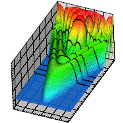Department of Physics and Astronomy: Publications and Other Research

Anthony F. Starace Publications
ORCID IDs
J. M. Ngoko Djiokap https://orcid.org/0000-0003-4702-3544
Document Type
Article
Date of this Version
2021
Citation
PHYSICAL REVIEW A 103, 053110 (2021)
DOI: 10.1103/PhysRevA.103.053110
Abstract
We use time-delayed, counter-rotating, circularly polarized few-cycle attosecond nonoverlapping pulses to study the temporal coherent control of the resonant process of two-photon double ionization (TPDI) of hydrogen molecule via doubly excited states for pulse propagation direction along ˆk either parallel or perpendicular to the molecular axis ˆR. For ˆk ‖ ˆR and a pulse carrier frequency of 36 eV resonantly populating the Q2 1∏ + u (1) doubly excited state as well as other 1∏ + u doubly excited states, we find that the indirect ionization pathway through these doubly excited states changes the character of the kinematical vortex-shaped momentum distribution produced by the two direct ionization pathways from fourfold to twofold rotational symmetry. This result is similar to what found in TPDI of the He atom involving 1Po± 1 doubly excited states [Ngoko Djiokap and Starace, J. Opt. 19, 124003 (2017)]; however, angular distributions exhibiting a quantum beat effect between the ground state and a doubly excited state seen for the He atom are observed here for its molecular counterpart with an anomaly in shape and magnitude, not in frequency. The sixfold differential probability integrated over the azimuthal angle of the photoelectron pair shows that this anomaly is due to autoionization decays and quantum beats between doubly excited states. For ˆk ⊥ ˆR and a broadband pulse carrier frequency of 30 eV populating the Q1 1∏ + u (1), Q1 1∑ + u (1), Q2 1∏ + u (1), and Q1 1∑ + u (2) doubly excited states, the momentum distribution is shown to exhibit dynamical electron vortices with four spiral arms, which originates from the interplay between the 1Δ + g , 1Π+ g , and 1Σ + g dynamical ionization amplitudes. Our treatment within either the adiabatic-nuclei approximation or fixed-nuclei approximation shows that the latter provides a very good account for this correlated process.
Included in
Atomic, Molecular and Optical Physics Commons, Elementary Particles and Fields and String Theory Commons, Plasma and Beam Physics Commons


Comments
©2021 American Physical Society